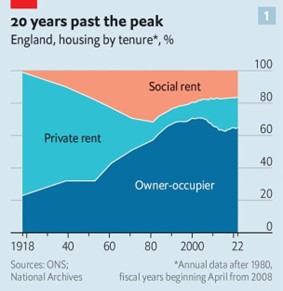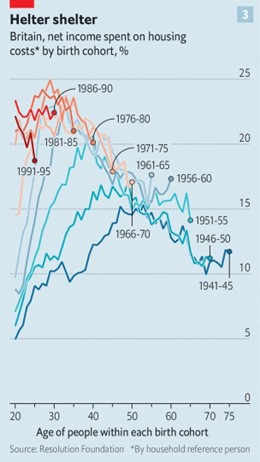Occasionally an article comes along that encapsulates what you’re thinking. In the January 11 Economist there was an article entitled ‘The Housing Ladder, 1950-2005’ (https://econ.st/48Svcls note paywall) which came close to summing up my gloom about housing policy over recent decades. Its key theme is that ‘a redundant metaphor (the housing ladder) is blinding policymakers’.
The ‘housing ladder’ has been with us as an idea for a long time, and I remember being subject to endless images of ladders when I was on the board of a major housing association, being used to justify turning away from the production of social rent homes. It was linked closely to the other deadly notion of aspiration, which was of course defined in a way that suited the new policy.
I used to argue a) that the first step on the real housing ladder is a decent affordable home in any tenure, noting that the ladder might only have one rung, and that b) being brought up in an aspirational working-class family meant that my parents wanted their children to stay at school and have better chances in life, their own wishes to own a home were real but secondary. I always hoped that the housing ladder as a concept would wither away and stop being so damaging to the emergence of a comprehensive cross-tenure housing policy, but it looks once again that it will be the main housing topic when the general election comes.
Of course, calling out the housing ladder as a myth is likely to get you classified as a wild-eyed loon – it is so firmly in the centre of housing’s Overton window (ie the range of acceptable opinion) and is used by media and politicians of all shades all the time – so it’s great to see a serious mag taking the idea to task.
‘The housing ladder’ is the notion that aspiring people will naturally progress (through thrift and hard work – and by avoiding smashed avocado on toast) from buying a modest flat (or even a share of one) at a young-ish age then trading up over the years as incomes grow and housing equity increases.

The problem is the facts no longer fit the fable, as the article shows. Home ownership peaked 20 years ago at 70% and has since fallen despite vast policy interventions. The ratio of house prices to earnings was around four from 1950s-1990s and is now eight. Home ownership before 30 is now around a third when it used to be more than a half and is increasingly dependent on inherited wealth or family support. Those who make it onto the ladder are much less likely to trade up. The flood of easy mortgage finance across the world following financial deregulation is now a thing of the past, after the USA mortgage market triggered the global financial collapse, and homeowners’ vulnerability to higher interest rates is now plain to see. The Tories, at huge cost, have tried to reinvigorate home ownership through demand subsidies, but the 1990s paradigm isn’t returning any time soon.

The article places the right to buy of council homes in this context, noting that this ‘one time trick’ transferred a tenth of the housing stock from the state to private ownership in a little over a decade, costing billions but giving a major boost to the appearance of success of home ownership. It also comments that even the successful implementation of the target to build 300,000 homes a year for a decade would only reduce the house-price to earnings ratio to 7. It argues that the ageing population means that homes recycle back onto the market much more slowly than they did.
Normally if I make this kind of argument I get challenged with the sneer: ‘I bet you are a homeowner’. Indeed, I am, and I’m a classic housing ladder person although without much trading up – starting in a council house, fortunate to buy a share of a £15,000 London house in a poor area in the 1970s because it was cheaper than private renting, just when Westminster Council allowed joint mortgages between unrelated people for the first time. All I had to do was sit and watch the value rise. But the responsibility of the lucky generation – mine – is to think about what policies are suitable for the less lucky generations that have followed.
So, as the article states, the private rented sector is no longer ‘a waiting room’ prior to home ownership. It is a destination. Social housing has been shrunk massively and deliberately and can no longer meet more than a small share of need. Those who get into home ownership are taking on mortgages well into normal retirement age. The housing costs of older people – home owners and private renters alike – are escalating rapidly, pensioner poverty will rise, and the state will catch much of the burden.
“The housing ladder may have died two decades ago but its allure as a metaphor remains. That continues to blind Britain’s politicians and voters to the reality of the property market. Rather than harking back to a bygone age, Britain’s politicians need to accept that there is more to housing than home ownership.”
The Economist.
The case I’ve always made is for a comprehensive national housing strategy that covers all tenures, building on their strengths and tackling their weaknesses. It will take a generation to turn things around and to stop housing costs crippling most of our households. In case you doubt it, I support home ownership as the preference and the best solution for many households. It will rise again in a sustainable way when peoples’ incomes rise in relation to property prices, so we should build more, subsidising supply where it is sensible but not wasting cash on demand subsidies that push prices up. We must tackle land costs and developers’ profit-first models. We must build much more social housing for those that need decent homes at lower rents, a hugely successful model that requires investment but not ongoing subsidy. And we must professionalise the private rented sector, the last great unmodernised industry, defining its role more clearly as home ownership and social rented gradually climb back, as surely they will.
See ‘The Housing Ladder, 1950-2005’, The Economist Jan 11 2024. Online https://www.economist.com/britain/2024/01/11/the-housing-ladder-1950-2005 (note paywall). No byline.
Steve Hilditch was a founder member of LHG when it formed 42 years ago, and edited Red Brick blog for 10 years, publishing a compendium book of 100 posts in 2020. He has worked as a housing professional and consultant, advising the last Labour Government, various Select Committees and many Labour Councils on housing matters. He recently carried out a detailed housing review for the new Labour Westminster Council.

3 replies on “More Snakes than Ladders”
Absolutely on the money again, Steve. I often feel the need to throttle any politician who begins to utter that hackneyed and misleading phrase “the housing ladder”.
The only certain factor is that old people will die and their homes be either inherited or sold to young(er) people, but probably later than they really needed to raise a family in comfort and security.
In 1967 I moved into a furnished room in Kilburn Park Road NW6. Opposite was a short road with two small shops. The grocers – Muriel and Dick Purdy – were Labour Party members and very helpful. Each morning I joined the queue of women in slippers and curlers to buy a pint of milk, a loaf of bread and 5 Woodies. They all lived in similar houses – often a family in one room – and had been ‘on the list’ for decades. Their aspiration was to become Council tenants. Not long afterwards their homes were demolished and replaced by Council flats – South KIlburn, now demolished again. Nearby the GLC built the Harrow Road estate and friends from nearby streets moved into Chantry and Hermes Points – 24 storeys high – and Athens Gardens – 4 storey of maisonettes. They loved having a bath, and the views from the tower blocks were astounding. Not long after they moved in the windows of Chantry Point started to fall out and the end wall of Athens Gardens began to detach itself. (Much later asbestos was found in Chantry Point, which led to its demolition.) I moved to East Ham shortly after the Ronan Point disaster. So much social housing was built badly, and residents’ views and knowledge ignored. I hoped (the hopes of ignorant youth) that community based non profit organisations would do better; Walter and Elgin Community Housing is one of very few that have done so. Housing associations started off with good intentions but grew and many – most ? – became more interested in their balance sheets than providing a service to tenants. Before the Right to Buy many council tenants wanted out – they wanted a house with a garden and to no longer rely on the Council to keep their home in good condition. Meanwhile funds to build social housing dried up. Sadly Councils’ performance as landlords improved dramatically; Compulsory Competitive Tendering and the Decent Homes Standard – seemed to have provided – albeit belatedly – the necessary spurs. As genuinely affordable housing diminished – unsurprisingly – homelessness increased. Social housing became housing for the poorest. There’d always been a rather punitive attitude to ‘problem’ families and many social landlords failed to recognise their new responsibilities to them. Were these consequences forseen or forseeable ? Can we make a new progress ? Can we show people thinking that only owner occupation is their best hope ? Indeed can young people without wealth ever become owner occupiers ? The post war concensus on a fair society seems lost; can we rebuild this ?
‘stop’ not ‘show’ …